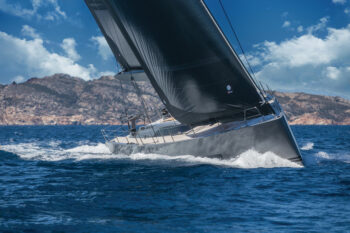Your Local Broker, Internationally
Berthon UK
(Lymington, Hampshire - UK)
Sue Grant
sue.grant@berthon.co.uk
0044 (0)1590 679 222
Berthon Scandinavia
(Henån, Sweden)
Magnus Kullberg
magnus.kullberg@berthonscandinavia.se
0046 304 694 000
Berthon Spain
(Palma de Mallorca, Spain)
Simon Turner
simon.turner@berthoninternational.com
0034 639 701 234
Berthon USA
(Rhode Island, USA)
Jennifer Stewart
jennifer.stewart@berthonusa.com
001 401 846 8404
Performance Yacht Review | 2021
By Ben Cooper
Can’t think, brain’s numb, inspiration won’t come. Bad ink, rotten pen, best wishes, amen. A ditty that appeared in every birthday card from a relative when I was younger. Still jumps out of my cerebral cortex when faced with a blank sheet of paper (screen). Doesn’t help much though.
2020 of course was a ‘different’ year. It reminded me of a snow globe; a reasonably stable world was picked up and shaken furiously, and now is finally starting to settle again, medically, politically and financially speaking.
One would be forgiven (us included) for assuming like many other industries, that the world of yachting would be amongst the ones hit very hard, but after an inevitable initial stun, the sun came out, the phone started ringing and we were very quickly from lockdown to heads down. And it continues into 2021.
The racing yacht market was naturally the most affected in 2020. Quite quickly, clubs and organisations first of all rescheduled regattas and events, and consequentially cancelled in turn with the situation leading to a lot of wallet sitting – quite understandably. However now that the dust (snow?) is starting to settle, the light is at the end of the tunnel (no more analogies I promise). Regattas are being promoted again and turn-key yachts that are on the market are generating a lot of interest and selling for 2021 racing. The start of 2021 has been very fruitful. Long may it continue!
Leading the way out is the Australasian market, mostly due to seasonal factors, but also a relatively well controlled reaction to the world situation. Coastal racing and short offshore is a forte there, and fast, planing and competitive yachts are following the gravitational pull of the sun and strong winds. Europe is starting to move; the Fastnet was sold out in record time again, the updated course is not proving to be as badly received after all. It certainly will add another dimension.
This leads conveniently onto the continuing move towards offshore and coastal racing, a strengthening polarisation of inshore to one design and offshore in handicap racing. Regattas in 2021 are unlikely to be a largely social affair, so offshore is an obvious tonic. For those that enjoy their racing in a more high energy spirit, inshore one design is flourishing. However the yachts are growing smaller and smaller, bang for buck is a continual and never overused moniker. With the progress of design and faster and faster yachts being more competitive, the traditional coastal and short RORC races are now around 24 hours for the faster yachts at 40ft. These races are now starting to be treated as long inshore rather than offshore, no watch system and back before closing time or breakfast. This seems to be as attractive as an endless windward leeward course and a number of enthusiasts have a small one design for inshore and a larger yacht for the coastal races.
As a subset of this emerging market, the doublehanded scene, perhaps buoyed a little by the inclusion into the 2024 Olympics, has grown significantly. Class 40 racing has always been a strong pathway. The yachts are more and more scow like and faster and faster offwind. How long before all IRC yachts start to go this way?
Performance cruising continues its popularity, now striding its way in to the larger and larger yacht market. Continued enthusiasm for Superyacht racing has a few yachts being specifically designed with the obvious benefit of large interior volume and hence the dual nature of the yacht.
The Mediterranean style performance cruising yacht lends itself well to the dual nature of racing and cruising, as both require clean and uncluttered decks, reasonably low freeboards and coachroof. 45 – 50 ft gives enough interior volume for comfort, whilst maintaining the high visibility, minimalist deck layout.
Form stability is pushing the envelope as well, with wider and wider transoms, maximum beam being pushed further and further forward, both for righting moment, and balance, and this comes with twin rudders on some. The added benefit of increased interior volume is exciting the interior designers and we are now seeing some moves away from the traditional interior layout, the chart table now being a thing of the past and lateral arrangements are sneaking in.
Caution is required though, for this hull form will only work on a light displacement yacht. Tempting though it is to add watermaker, air-conditioning, upgraded engine, etc etc, it is all to the detriment of the ultimate prize – rewarding sailing performance.
This market has done well in 2020. Manufacturers have full order books, and the best examples of new yachts are unavailable until 2022 at the earliest. Demand is still pushing the supply chain in brokerage and we are seeing a dearth of good, well looked after and recent yachts, which are commanding good prices and selling at small discounts if any. More and more pressure is coming on the market, despite high demand buyers are demanding turn-key yachts, and hence anything with work to do will have to be sympathetically priced to attract a new custodian.
For 2021, it is hard to predict and I will look back in interest at this time next year when I am pressed for my late copy again to see how it has all changed. We are in a fast moving and reactionary world, just one step away from the snow globe being picked up again. One thing is clear though – our global community is united in wishing to reach ‘normal’ again. For many this means heading out to sea, for which we are truly grateful and will be here to help in every way.

